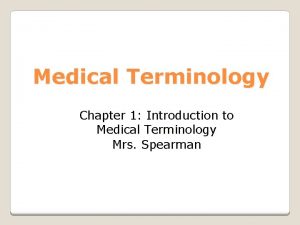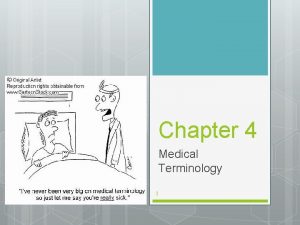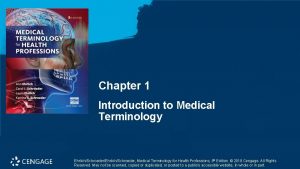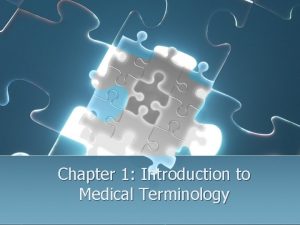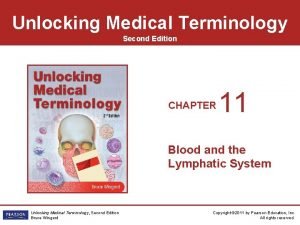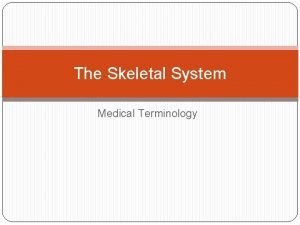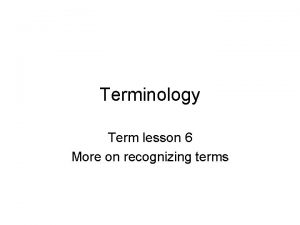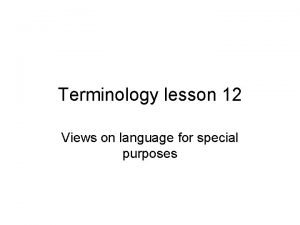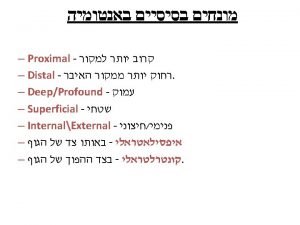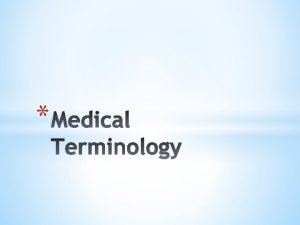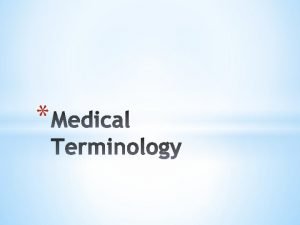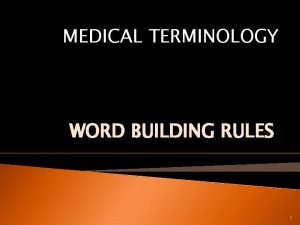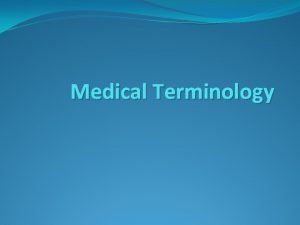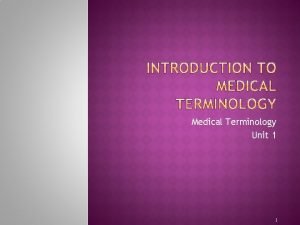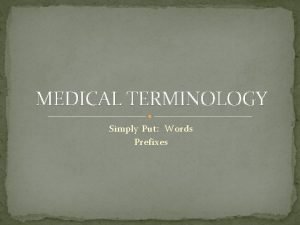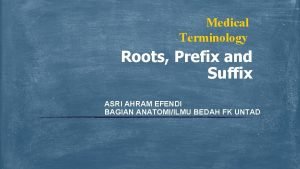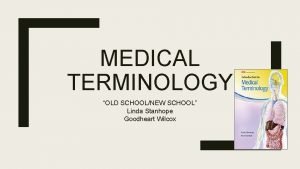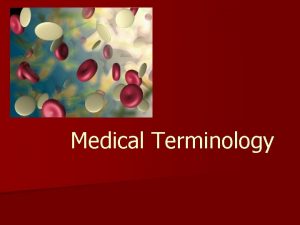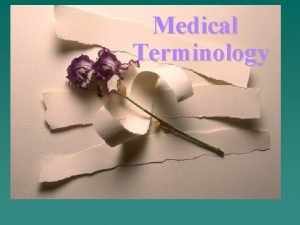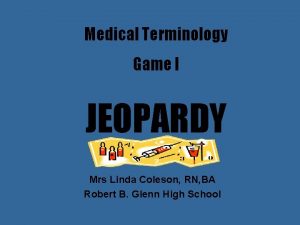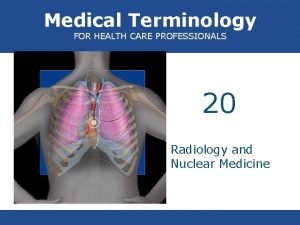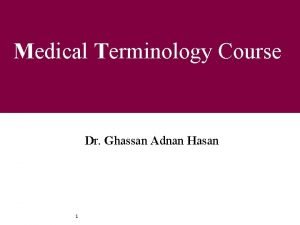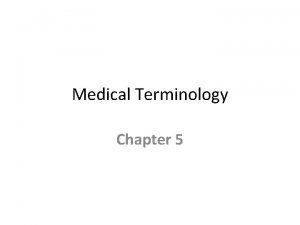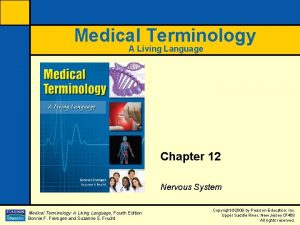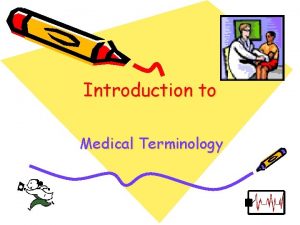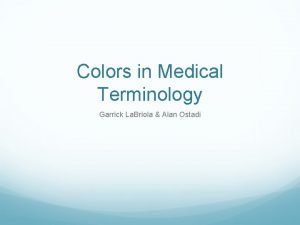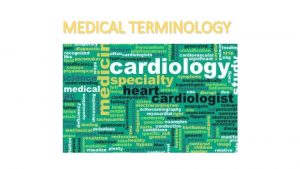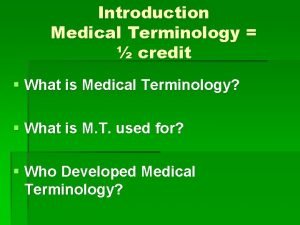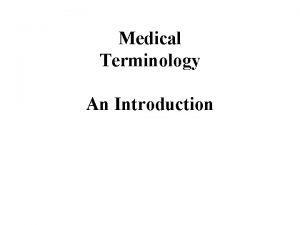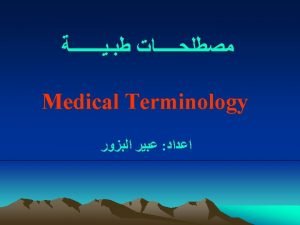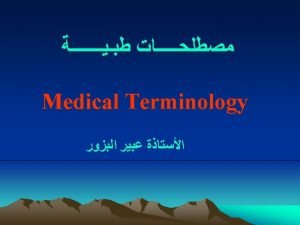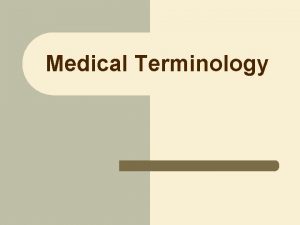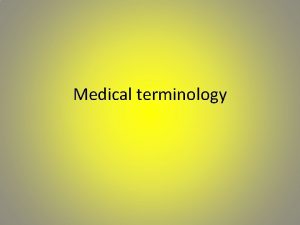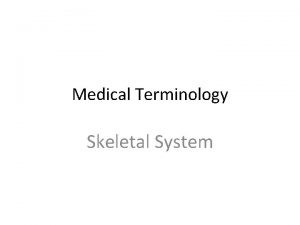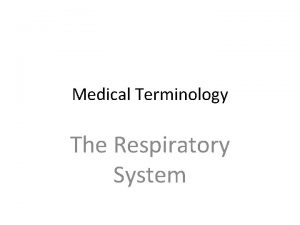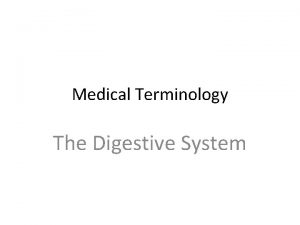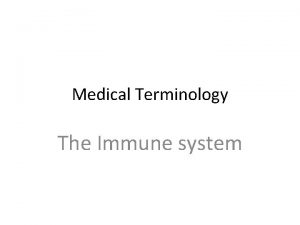Introduction to Medical Terminology In your groups think








































- Slides: 40

Introduction to Medical Terminology

In your groups, think of reasons WHY it would be important to at least be familiar with some medical terminology. THINK – PAIR – SHARE (1 MIN)

ORIGINS OF MEDICAL LANGUAGE

Greek and Latin word parts • Composes the majority of medical terms

Eponyms • Derived from the name of a person • Example: – Alzheimer Disease

Acronyms • Abbreviation of a phrase • Can be spoken as a whole word • Example: LASER – Light Amplification by Stimulated Emission of Radiation

Modern Language • Derived from the English language • Example: – Nuclear Medicine Scanner

Practice • A. components of greek and latin word parts • B. eponym • C. acronym • D. modern language • Parkinson disease _____ • hepatitis _____ • MRSA (methicillin-resistant Staphylococcus aureus) _____ • postraumatic stress disorder _____ • arthritis _____ • nuclear medicine scanner _____ • AIDS (aquired immunodeficiency syndrome) _____ • Alzheimer disease _____

Answers • A. components of greek and latin word parts • B. eponym • C. acronym • D. modern language • 5. arthritis - A • 6. nuclear medicine scanner - D • 7. AIDS (aquired immunodeficiency syndrome) - C • 8. Alzheimer disease - B

Answers • A. components of greek and latin word parts • B. eponym • C. acronym • D. modern language • 1. Parkinson disease - B • 2. hepatitis - A • 3. MRSA (methicillin-resistant Staphylococcus aureus) - C • 4. posttraumatic stress disorder - D

Categories of Medical Terms built from word parts Terms not built from word parts • From Greek and Latin Roots • Can be literally translated • Example: • Eponyms, acronyms, and modern language • Cannot be literally translated • Example: – Arthritis • Arth/itis – Alzheimers Disease

Four Word Parts MEDICAL TERMS BUILT FROM WORD PARTS

Word Root • Core of the Word • Examples: – Play/er

Suffix • End of the word root modifies its meaning • Examples: – Play/er

Prefix • Attached to the beginning of a word root to modify it’s meaning • Example: – Re/play – Sub/hepat/ic – Intra/ven/ous

Combining Vowel • Word Part • Usually an “o” • Ease pronunciation

Combining Form • Word root + combining vowel • Separated by a vertical slash • Example: – Arthr/o

Practice • 1. Attached at the beginning _____ • • 2. Usually an o _____ • • 3. All medical terms include at least one _____ • • 4. Attached at the end of a word root _____ • • 5. Word root with combining • vowel attached _____ A. Combining vowel B. Prefix C. Combining Form D. Word Root E. Suffix

Practice • 1. Attached at the beginning ___B__ • 2. Usually an o __A___ • 3. All medical terms include at least one _D____ • 4. Attached at the end of a word root _E____ • 5. Word root with combining vowel attached ___C__ • A. Combining vowel • B. Prefix • C. Combining Form • D. Word Root • E. Suffix

FOUR(ISH) GUIDELINES FOR USING COMBINING VOWELS

Number 1 • Word root + suffix • CV used if the suffix does NOT begin with a vowel • Example: – Arthr/o/pathy

Number 2 • Word root + suffix • CV NOT used if the suffix begins with a vowel • Example: – Hepat/ic

Number 3 • Word roots + word root • CV is used even if vowels are present at the junction • Example: – Oste/o/athr/itis

Number 4(ish) • Prefix + Word root • CV is NOT used • Example: – Sub/hepat/ic

Practice (T or F) if false give the reason WHY… • 1. There is always prefixes at the beginning of medical terms • 2. A combining vowel is always used when connecting a word root and a suffix that begins with the letter o. • 3. A prefix modifies the meaning of the word. • 4. A combining vowel is used to ease pronunciation. • 5. I is the most commonly used combining vowel.

• 1. There is always prefixes at the beginning of medical terms • F – A medical term may begin with the word root and have no prefix • 2. A combining vowel is always used when connecting a word root and a suffix that begins with the letter o. • F – If the suffix begins with a vowel, the combingin vowel is usually not used • 3. A prefix modifies the meaning of the word. • T

• 4. A combining vowel is used to ease pronunciation. • T • 5. I is the most commonly used combining vowel. • F – O is the most commonly used

More T/F Practice • 6. The word root is the core of a medical term. • 7. A combining vowel is used between a prefix and a word root. • 8. A combining form is a word part. • 9. A combining vowel is used when connecting a word root and a suffix if the suffix begins with the letter g.

Answers • 6. The word root is the core of a medical term. • T • 7. A combining vowel is used between a prefix and a word root. • 7. F – A combining vowel is used between two word roots or between a word root and a suffix to ease pronunciation

Answers • 8. A combining form is a word part. • F – A combining form is a word root with a combining vowel attached and is not one of the four word parts • 9. A combining vowel is used when connecting a word root and a suffix if the suffix begins with the letter g. • T

Word Part List Word Roots Definition Suffixes Definition Arthr Joint -it is Inflammation Hepat Liver -ic Pertaining to Ven Vein -ous Pertaining to Oste Bone -pathy Disease -megaly enlargement Prefixes Intra- Within Sub- Under Combining Vowel O

Create some note cards! • Create note cards for your med terms or use quizlet! – Front Terms – Back Definitions • Then use them to quiz your lab partner!

Practice: Use the word part list to complete the following exercise… • Identify the word parts and their meanings, analyze and define the following terms. • Example: Osteoathropathy • • Athritis Hepatitis Subhepatic Intravenous Arthropathy Osteitis Hepatomegaly

Answers • 1. Arthr/itis (inflammation of the joint) WR S • 2. hepat/itis (inflammation of the liver) WR S • 3. sub/hepat/ic (pertaining to under the liver) P WR S • 4. intra/ven/ous (pertaining to within the vein) P WR S

Answers • 5. arthr/o/pathy (disease of the joint) WR CV S • 6. oste/itis (inflammation of the bone) WR S • 7. hepat/o/megaly (enlargment of the liver) WR CV S

Practice: Building Medical Terms • • Example: Disease of a joint 1. find the word for disease 2. find the word for joint 3. does it need a CV?

Practice: Building Medical Terms 1. Inflammation of the joint WR/S 2. Pertaining to the liver WR/S 3. Pertaining to under the liver P/WR/S 4. Pertaining to within the vein P/WR/S 5. Inflammation of the bone WR/S 6. Inflammation of the liver WR/S 7. Disease of the bone and joint WR/CV/S • 8. Enlargement of the liver WR/CV/S • •

Answers: • • 1. arthr/it is 2. hepat/ic 3. sub/hepat/ic 4. intra/ven/ous 5. oste/it is 6. hepat/it is 7. oste/o/arthr/o/pathy 8. hepat/o/megaly

WHAT ABOUT THE WORDS YOU CAN’T BREAK DOWN?

Exit Slip: Lets see how much you remember! • Identify the word parts and their meanings, analyze and define the following terms: – Arthromegaly – Venopathy • Identify the correct medical term for the description – Inflammation of the bone – Pertaining to (-ous) within the vein
 Think big think fast think ahead
Think big think fast think ahead Chapter 1 matching medical terminology
Chapter 1 matching medical terminology Cyan medical term example
Cyan medical term example Chapter 4 introduction to medical terminology
Chapter 4 introduction to medical terminology Chapter 1 introduction to medical terminology
Chapter 1 introduction to medical terminology Chapter 1 introduction to medical terminology
Chapter 1 introduction to medical terminology How are ethnic groups and religious groups related
How are ethnic groups and religious groups related Think said the robin think said the jay
Think said the robin think said the jay Think fam think
Think fam think Chapter 11 medical terminology
Chapter 11 medical terminology Medical terminology skeletal system
Medical terminology skeletal system Superior and inferior
Superior and inferior Lesson 6 medical terminology
Lesson 6 medical terminology Medical terminology lesson 12
Medical terminology lesson 12 Phleb prefix meaning
Phleb prefix meaning Tresia medical term
Tresia medical term Kidney medical term prefix
Kidney medical term prefix Khan cademy
Khan cademy Word building rules
Word building rules Root word medical terminology examples
Root word medical terminology examples Lacrim/o combining form
Lacrim/o combining form Esis medical term examples
Esis medical term examples Py/o medical term
Py/o medical term Contrasting prefixes medical terminology
Contrasting prefixes medical terminology Gastroenteritis suffix
Gastroenteritis suffix Medical terminology activities high school
Medical terminology activities high school Basic medical terminology list
Basic medical terminology list Phylaxis suffix meaning
Phylaxis suffix meaning Are medical terms universal
Are medical terms universal Color in medical terminology
Color in medical terminology Medical jeopardy questions
Medical jeopardy questions Radiology terminology
Radiology terminology Accented syllable in retrogastric
Accented syllable in retrogastric Throat medical terminology
Throat medical terminology Perineuritis medical terminology
Perineuritis medical terminology Erect position medical terminology
Erect position medical terminology Thalam medical term
Thalam medical term Ventral dorsal position
Ventral dorsal position Medical terminology symbols
Medical terminology symbols Integumentary
Integumentary Anthrac/o medical term
Anthrac/o medical term


